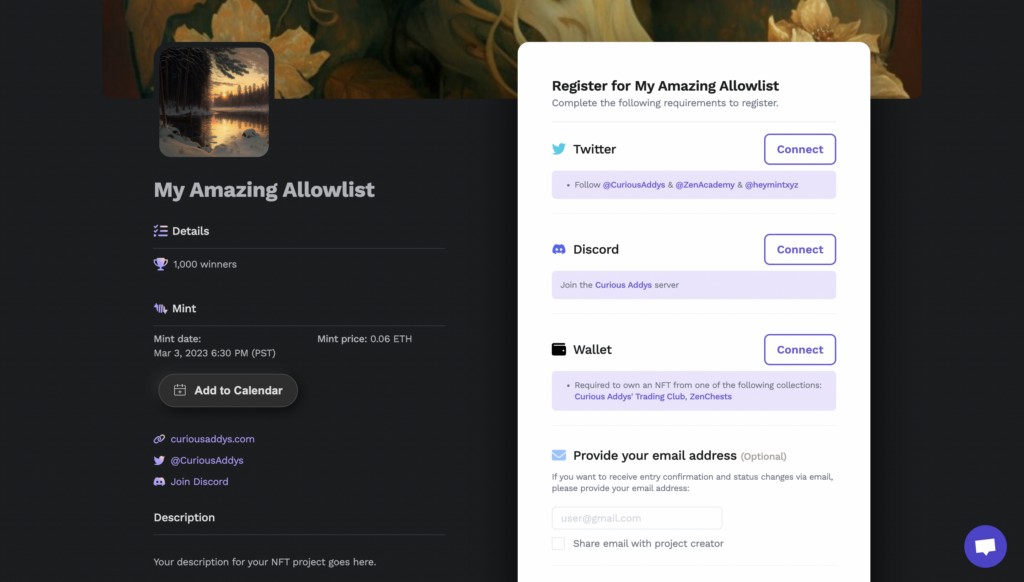
Whitelists (aka allowlists) are a crucial part of the marketing and launch strategy of most NFT projects today. But what is a whitelist NFT? Like a digital velvet rope, they help build demand, provide some protection, and ensure that only desired clientele are allowed in. However, how spots to these projects are earned and distributed have consistently been a rather prickly topic among collectors and creators.
This short article will explain what whitelists are used for, as well as their advantages and disadvantages. We’ll also tell you how can make your own whitelist completely free, using our allowlist manager, HeyMint.
What is a Whitelist NFT Used For?
*Note: for the remainder of this article we will be substituting “whitelist” with “allowlist” interchangeably. We’ll give the reason for that in the next section.*
An allowlist is a series of crypto wallet addresses that have been pre-approved to mint. As mentioned before, it’s almost like a VIP pass to a digital private club, guaranteed to be let in ahead of the crowd. What this means is that those who are allowlisted are granted early access to mint the NFT before anyone else.
Why is this a big deal? Well, most NFT collections today use allowlists, turning to a public mint only after the allowlisted members have been given the opportunity to mint first. Additionally, sometimes a project will manage to mint out (sell) their entire collection in an allowlist presale, forgoing any public sale whatsoever.
Because of this, allowlist spots are sought after not only by those who are legitimately interested in the project, but traders and flippers as well, who are only looking to maximize their potential profits. In many cases these two things are not mutually exclusive, and some people will mint multiple times so that they can remain a part of the community, but also hedge their bets by selling some of their mints on the secondary market.
How allowlist spots are given out is a different subject entirely, and differs from project to project. That being said, most allowlist spots are generally given to loyal members of the community who have shown an active interest and participation in the project.
Why Do You Call It an Allowlist?
Seemingly innocuous at first, the term “whitelist” is increasingly viewed as problematic by many people, who consider the term to have negative racial undertones.
At HeyMint, we generally prefer to use the term allowlist whenever possible. Other alternatives we’ve seen in the space include mintlist and goldlist.
With that being said, we recognize that the space has been slow to change their naming conventions. That is why we begrudgingly use both terms in this article, in case someone is unfamiliar with the word “allowlist”.
Advantages of Allowlists
There are notable advantages to incorporating an allowlist into your NFT project. Some of those perks include:
- Helping lower the chance of your collection being exploited by bots.
- Reducing gas charges, and significantly limiting the possibility (or at least extent of) gas wars. This is an expensive, competitive behavior where people overspend on gas fees in order to be granted priority minting. Gas fees can even be further reduced if the allowlist sale takes place significantly earlier than the public sale. Anywhere from 12 hours to a few days beforehand is more than enough.
- Minting from an allowlist is often the most cost effective option for a collector. Allowlist presale prices are generally the cheapest. Public sales are in the middle. Secondary NFT marketplaces like OpenSea, Blur, and Rarible are often the most expensive, due to NFT owners marking up their selling price.
- Coupled with a requirement for a minimum wallet balance (possible with HeyMint), creators can increase the likelihood of building an allowlist full of motivated buyers who not only have the desire, but also the means to mint your project come launch day.
- Traders benefit from allowlists not only for the cheaper cost and potential to mint a rare NFT which may fetch higher prices, but also because traders typically relist some of their mints at a significant markup on NFT marketplaces.
- Allowlists double as marketing. Most people get onto allowlists by sharing, liking, and retweeting content from the creator. If enough people take part online, it can begin to create a sense of urgency (otherwise known as “FOMO”) which may inspire those sitting on the sidelines to buy in as well.
- While these figures have likely changed in the past couple of years, in a 2021 NFT Market Report by Chainalysis, they said:
[Allowlisting] isn’t just some nominal reward — it translates to dramatically better investing results. OpenSea data shows that users who make the [allowlist] and later sell their newly-minted NFT gain a profit 75.7% of the time, versus just 20.8% for users who do so without being [allowlisted]. Not only that, but the data suggests it’s nearly impossible to achieve outsized returns on minting purchases without being [allowlisted].
Disadvantages of Allowlists

There are two sides to every coin and allowlists are not without their drawbacks:
- Getting on an allowlist often requires a significant investment in time, focus, and active participation. This can last weeks or even months. Those hours spent chasing a potential opportunity could likely be better spent elsewhere.
- One of the most popular allowlist tactics on Twitter involves getting your audience to like, retweet and tag multiple friends. This constant shilling by thousands of projects floods social media, and makes it difficult to find worthwhile communities.
- Many allowlist tactics are built around creating FOMO (“fear of missing out”). This pressure results in a lot of people making poor financial decisions. Given enough time to properly consider all aspects of a project, FOMO can be overcome.
- Allowlists are an easy target for scammers. Scammers will set up fake Twitter accounts and Discord servers to phish users. But they don’t stop there. Many scammers create fake mint websites, and even false NFT collections. The more popular a project is, the more likely it’ll be targeted. And, if you don’t do your research, sooner or later you’ll fall for one of them. But you aren’t powerless. Start by reading NFT Scams: 10 Types You Need to Know for more information about many of the most common scams you may encounter online.
- Allowlist spots are intentionally limited and competitive in an effort to artificially inflate demand. As such, your chances of getting on a list are not guaranteed, particularly if the project is hyped or seemingly set to be very successful.
How To Make An Allowlist with HeyMint
When you make a free allowlist with HeyMint, the first thing you’ll notice is that it has more functionality possible than any allowlist manager on the market. You can custom tailor your requirements to the exact needs of your project, no matter how simple or complex.
HeyMint supports a variety of requirements including: liking or retweeting specific tweets, following specific accounts, joining Discord servers or holding specific roles, setting a minimum wallet balance, holding a token (or tokens) of specific NFT collections, and so much more. One of my favorite options is the ability to include an “add to calendar” button on your allowlist. With a simple click, your followers can opt in to be promptly reminded of your mint come launch day. How cool is that?!
HeyMint is proud to support Ethereum, Solana, Optimism, and Arbitrum blockchains. Don’t see the blockchain you use? We’ll always considering adding more if the demand is there.

With HeyMint, we put no restrictions on how many projects you can create. It’s unlimited. Use it to your heart’s content for all of your allowlist needs!
Closing
So now you know what is a whitelist NFT. In the right hands, allowlists can be grown and cultivated with love and foster the exact type of community you’re trying to develop. They can also be nothing more than a mechanism for scammers to try and rug strangers on the internet. That is why taking your time to research a project before it launches is critical. Good projects may draw in like-minded individuals, but anywhere there’s money to be made, there will be people trying to game the system.
Rather than getting on as many allowlists as you can and hoping for the best, we advise quality over quantity. If you seek out projects which resonate with you and are led by a team that you trust and support, your time in the space is bound to be much smoother.
Until next time!
Further Reading

How to Start an NFT Collection
NFTs for Dummies
NFT Terminology
How to make an NFT for Free
Curious Addys Newsletter
